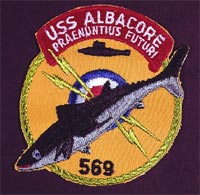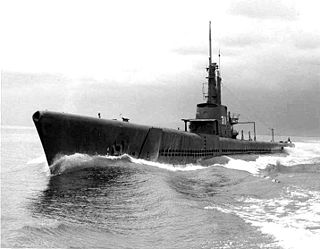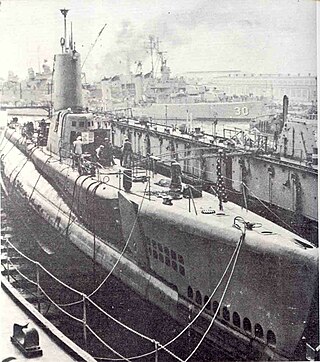
USS Seawolf (SSN-575) was the third ship of the United States Navy to be named for the seawolf, the second nuclear submarine, and the only US submarine built with a liquid metal cooled (sodium), beryllium-moderated nuclear reactor, the S2G. Her overall design was a variant of Nautilus, but with numerous detail changes, such as a conning tower, stepped sail, and the BQR-4 passive sonar mounted in the top portion of the bow instead of further below. This sonar arrangement resulted in an unusual bow shape above the water for a U.S. submarine. Originally laid down in 1953, her distinctive reactor was later replaced with a standard pressurized water reactor, the replacement process lasting from 12 December 1958 to 30 September 1960.

USS Nautilus (SSN-571) was the world's first operational nuclear-powered submarine and the first submarine to complete a submerged transit of the North Pole on 3 August 1958. Her initial commanding officer was Eugene "Dennis" Wilkinson, a widely respected naval officer who set the stage for many of the protocols of today's Nuclear Navy of the US, and who had a storied career during military service and afterwards.

USS Blueback (SS-581) is a Barbel-class submarine that served in the United States Navy from 1959 to 1990, and subsequently was made into an exhibit at the Oregon Museum of Science and Industry. She was the second Navy submarine to bear the name.

USS Sailfish (SSR/SS/AGSS-572), the lead ship of her class of submarine, was the second ship of the United States Navy to be named for the sailfish, a large gamefish inhabiting tropical seas, related to the swordfish, but possessing scales and a large sail-like dorsal fin.

USS Salmon (SSR/SS/AGSS-573), a Sailfish-class submarine, was the third ship of the United States Navy to be named for the salmon.

USS Albacore (AGSS-569) is a unique research submarine that pioneered the American version of the teardrop hull form of modern submarines. The revolutionary design was derived from extensive hydrodynamic and wind tunnel testing, with an emphasis on underwater speed and maneuverability. She was the third vessel of the United States Navy to be named for the albacore.

USS Mackerel (SST-1), originally known as USS T-1 (SST-1), was the lead ship of the T-1-class of training submarines. She was the second submarine of the United States Navy named for the mackerel, a common food and sport fish, and was in service from 1953 to 1973. She was one of the smallest operational submarines ever built for the U.S. Navy.

USS Narwhal (SSN-671), a unique submarine, was the third vessel of the United States Navy to be named for the narwhal, a gray and white arctic whale with a unicorn-like, ivory tusk.

USS Tang (SS/AGSS-563), the lead ship of her class, was the second ship of the United States Navy to be named for the tang.

USS Redfish (SS/AGSS-395), a Balao-class submarine, was the first ship of the United States Navy to be named for the redfish. In addition to her naval career, which included sinking the Japanese aircraft carrier Unryū, she made several film appearances in the 1950s.

USS Hawkbill (SSN-666), a Sturgeon-class attack submarine, was the second ship of the United States Navy to be named for the hawksbill, a large sea turtle. The name perpetuated the inadvertent misspelling of "hawksbill" in the naming of the first ship of that name, USS Hawkbill (SS-366), a Balao-class submarine launched in 1944. USS Hawkbill (SSN-666) was the eighteenth of 39 Sturgeon-class nuclear-powered submarines that were built.

USS Conger (SS/AGSS-477), a Tench-class submarine, was the only ship of the United States Navy to be named for the conger, an eel found in warm seas at moderate depths, common to both coasts of the Atlantic Ocean.

USS Snook (SSN-592), a Skipjack-class submarine, was the second ship of the United States Navy to be named for the common snook, an Atlantic marine fish that is bluish-gray above and silvery below a black lateral line.

USS Archerfish (SS/AGSS-311) was a Balao-class submarine. She was the first ship of the United States Navy to be named for the archerfish. Archerfish is best known for sinking the Japanese aircraft carrier Shinano in November 1944, the largest warship ever sunk by a submarine. For this achievement, she received a Presidential Unit Citation after World War II.

USS Medregal (SS-480/AGSS-480), a Tench-class submarine, was the only ship of the United States Navy to be named for the medregal, a streamlined, fast-swimming, bluish-colored fish of the jack family which abounds in waters of the West Indies and in the Atlantic as far north as the Carolinas.

USS Baya (SS/AGSS-318), a Balao-class submarine, was a ship of the United States Navy named for the baya. During World War II, she completed five war patrols in the South China Sea, Gulf of Siam, Java Sea, and Philippine Sea between 23 August 1944 and 25 July 1945. She sank four Japanese vessels totaling 8855 gross register tons, and shared credit with the submarine USS Hawkbill (SS-366) for sinking a Japanese 8,407-gross register ton passenger-cargo ship. After World War II, she saw service as a research submarine during the Cold War and operated off Vietnam during the Vietnam War.

USS Capitaine (SS/AGSS-336), a Balao-class submarine, was a ship of the United States Navy named for the capitaine, a brilliantly colored fish inhabiting waters of the Atlantic Ocean from North Carolina to Panama.

USS Preserver (ARS-8) was a Diver-class rescue and salvage ship commissioned by the U.S. Navy for service in World War II. She was responsible for coming to the aid of stricken vessels.

The T-1-class submarines were a pair of submarines designed by the United States Navy and built in the early 1950s for use in training submarine personnel and testing submarine equipment. Both submarines of the class served in these roles for over 19 years.





















